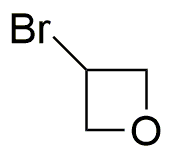3-Bromooxetane is widely utilized in research focused on:
- Synthetic Chemistry: It serves as a versatile building block in the synthesis of complex organic molecules, enabling chemists to create new compounds with desired properties.
- Pharmaceutical Development: This compound is explored for its potential in drug discovery, particularly in developing new therapeutic agents due to its unique structural features that can enhance biological activity.
- Material Science: 3-Bromooxetane is used in the formulation of advanced materials, including polymers and coatings, where its reactive nature can improve material performance and durability.
- Agrochemicals: It plays a role in the development of novel agrochemical products, potentially leading to more effective pesticides or herbicides that are environmentally friendly.
- Research Applications: In academic and industrial laboratories, it is utilized in various research projects, particularly in studying reaction mechanisms and developing new synthetic methodologies.
General Information
Properties
Safety and Regulations
Applications
3-Bromooxetane is widely utilized in research focused on:
- Synthetic Chemistry: It serves as a versatile building block in the synthesis of complex organic molecules, enabling chemists to create new compounds with desired properties.
- Pharmaceutical Development: This compound is explored for its potential in drug discovery, particularly in developing new therapeutic agents due to its unique structural features that can enhance biological activity.
- Material Science: 3-Bromooxetane is used in the formulation of advanced materials, including polymers and coatings, where its reactive nature can improve material performance and durability.
- Agrochemicals: It plays a role in the development of novel agrochemical products, potentially leading to more effective pesticides or herbicides that are environmentally friendly.
- Research Applications: In academic and industrial laboratories, it is utilized in various research projects, particularly in studying reaction mechanisms and developing new synthetic methodologies.
Documents
Safety Data Sheets (SDS)
The SDS provides comprehensive safety information on handling, storage, and disposal of the product.
Product Specification (PS)
The PS provides a comprehensive breakdown of the product’s properties, including chemical composition, physical state, purity, and storage requirements. It also details acceptable quality ranges and the product's intended applications.
Certificates of Analysis (COA)
Search for Certificates of Analysis (COA) by entering the products Lot Number. Lot and Batch Numbers can be found on a product’s label following the words ‘Lot’ or ‘Batch’.
*Catalog Number
*Lot Number
Certificates Of Origin (COO)
This COO confirms the country where the product was manufactured, and also details the materials and components used in it and whether it is derived from natural, synthetic, or other specific sources. This certificate may be required for customs, trade, and regulatory compliance.
*Catalog Number
*Lot Number
Safety Data Sheets (SDS)
The SDS provides comprehensive safety information on handling, storage, and disposal of the product.
DownloadProduct Specification (PS)
The PS provides a comprehensive breakdown of the product’s properties, including chemical composition, physical state, purity, and storage requirements. It also details acceptable quality ranges and the product's intended applications.
DownloadCertificates of Analysis (COA)
Search for Certificates of Analysis (COA) by entering the products Lot Number. Lot and Batch Numbers can be found on a product’s label following the words ‘Lot’ or ‘Batch’.
*Catalog Number
*Lot Number
Certificates Of Origin (COO)
This COO confirms the country where the product was manufactured, and also details the materials and components used in it and whether it is derived from natural, synthetic, or other specific sources. This certificate may be required for customs, trade, and regulatory compliance.


